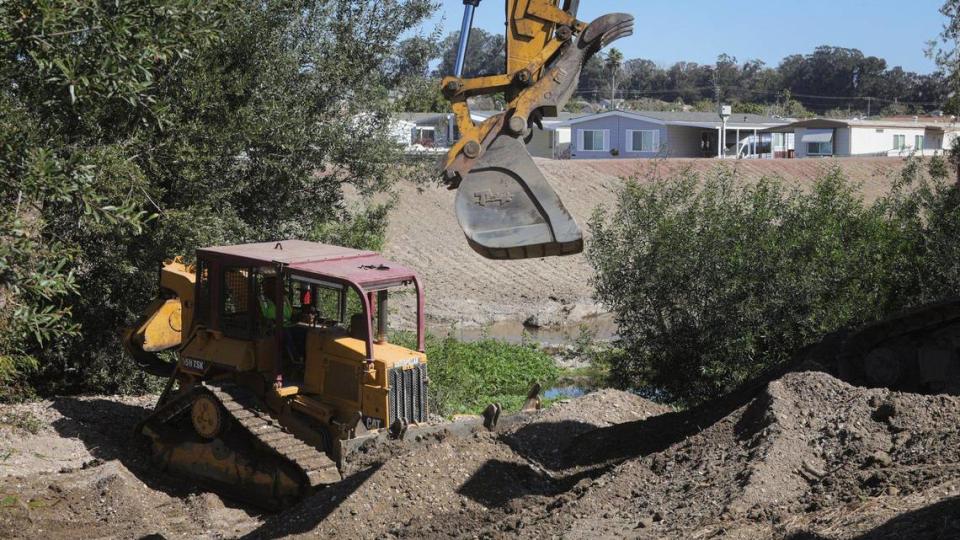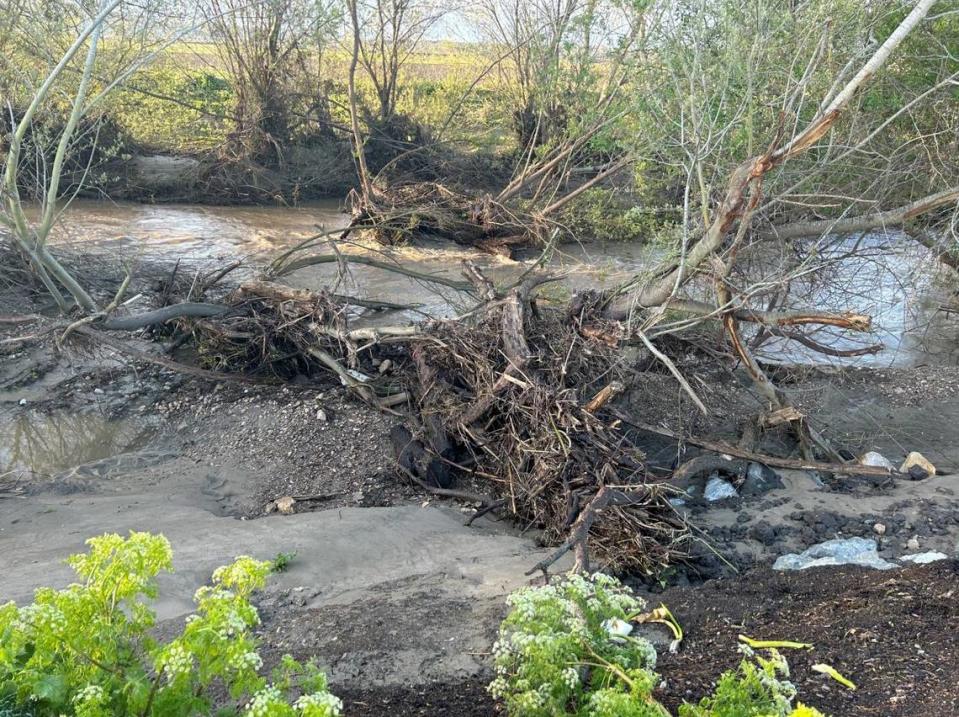El Niño could cause more flooding at Arroyo Grande Creek Levee. Here’s how to prepare
As winter approaches, San Luis Obispo County is preparing for more flooding near the Arroyo Grande Creek Levee in Oceano.
Meteorologists are predicting El Niño weather patterns for the West Coast this winter, which means San Luis Obispo County could be doused with another season of above-average rainfall.
Meanwhile, Lopez Lake is 95% full, which means it could more easily spill into Arroyo Grande Creek and threaten to breach the levee, according to Public Works Department Water Resources Division Manager Courtney Howard.
To prepare residents for another round of winter rain, San Luis Obispo County hosted a winter storm preparation meeting on Monday night for residents living near the Arroyo Grande Creek Levee.
“In January, February and March, we saw quite a lot of water,” Supervisor Jimmy Paulding said. “We want to make sure that if we see that level of rain and flooding events that we are prepared as a community.”
Status of the waterway
On Jan. 9, Arroyo Grande Creek breached the levee and flooded nearby homes and farmland in Oceano.
To prevent future flooding, the county launched a project to remove excess sediment from the creek, restore its flow capacity, and repair the levee to match its conditions prior to the winter storm series, according to Howard.
So far, the county removed vegetation and 11,000 cubic yards of sediment from the creek, restoring its flow capacity to 2020 levels.
Next, the county will install a hydraulic barrier in the middle of the levee to prevent water from flowing all the way through. The county is searching for a contractor, and will start construction within the next six months, Howard said.
Meanwhile, the county installed a plastic barrier in the levee to protect the area this winter.

Even with these precautions, its possible that floodwater will breach the levee depending on the amount of rain the county gets this winter, Howard said.
“There’s just a lot of variables and uncertainties,” Howard said. “Our message is just be prepared. Let’s be ready for what we experienced last season. It can happen again.”
When rain falls on the Arroyo Grande Creek Watershed, it drains into Lopez Lake.
If the lake fills, it spills into Arroyo Grande Creek, which then flows through the levee system out to the ocean, according to Howard.
Filled with rainwater from winter storms, Lopez Lake spilled for the first time in 25 years in March.
The lake is still nearly full, which means it could reach capacity quickly and overflow earlier in the season, Howard said.

When would the county order an evacuation?
When it starts to rain in the South County, all eyes are on the Arroyo Grande Creek Levee.
“During pretty much any storm, we’re paying attention and we’re getting ready,” Howard said.
The county will monitor the area more closely if rain falls at 0.2 inches per hour or the area receives 2 inches of rain during a 24-hour period, according to Howard.
The south side of the levee is at risk of water spilling over the top, Howard said, while the north side is also vulnerable to some flooding. The Meadow Creek and Oceano Lagoon area could also flood, Howard said.
When Meadow Creek is lower than Arroyo Grande Creek, the county opens a flap gate in the levee to allow Arroyo Grande Creek to drain into Meadow Creek.
When Meadow Creek rises, however, the county closes the levee gates to prevent flooding.
The county can take three types of action during an emergency:
Issue an evacuation warning, which asks residents to prepare to evacuate the area.
Issue an evacuation order, which requires residents to leave an area immediately due to a threat to life and property.
Issue a shelter-in-place order, which directs residents to stay in their homes.
The county will likely issue an evacuation warning if the creek rises to 27 feet at the 22nd Street Bridge while more rain falls, Howard said.
An evacuation order is likely at the south side of the levee if the creek reaches 29.5 feet at the 22nd Street Bridge, while the north side will likely evacuate if the creek reaches 30.5 feet at the bridge, according to Howard.
The Oceano Lagoon area would likely evacuate if the water gauge reaches 10 feet and more rain is on the way.
These numbers could change, though, based on the conditions, Howard said.
“We want to make sue that we’re giving the evacuation warning early so there’s plenty of time to get ready,” Howard said.
How to prepare for an emergency
To prepare for flooding, folks living near the levee should identify evacuation routes, make an emergency plan with their housemates about how to contact each other if cell phones go down, and plan where to meet if they are separated during an evacuation, according to SLO County Office of Emergency Services Director Scott Jalbert.
Residents also should take photos of their home in case the area floods and they have to report property damage to their insurance company.
Finally, people should always keep their gas tank three-quarters full and prepare a go-bag with food, water, a first-aid kit and medication, food and medication for pets, clothes and toiletries, cash, important documents, batteries, a phone charger and more, according to Jalbert.
The county’s website, prepareslo.org, includes more details on how to pack a disaster supply kit.

What do during an evacuation?
This winter, people living near the levee are likely to experience a few evacuation orders — and some might be false alarms, Jalbert said. He encouraged residents to follow evacuation orders every time they receive one, even if previous orders didn’t end in flooding.
“I understand that it’s completely inconvenient. It’s going to be troublesome, but it’s for your safety,” Jalbert said.
The county would issue an evacuation order through numerous channels, including:
A reverse 911 call (people must register their cell phones at emergencyslo.org to receive these calls)
Wireless emergency alerts
Social media posts
Reports in the news media
TV and radio alert system
Law enforcement notifying residents door to door
Siren system during extreme situations
Residents are evacuated by their evacuation zone, which folks can find at prepareslo.org.
In Oceano, homes south of the levee are in evacuation zone SLC-E315, north of the levee are FIV-E024, and the lagoon area is FIV-E025, according to Jalbert.
When the county issues an evacuation order, residents should leave their home within 15 minutes, Jalbert said.
Residents should secure their home when they leave — from turning off the stove to locking the front door — then drive carefully out of their neighborhood, according to Jalbert.
“People are distracted, so you have to be really attentive to drive safely,” Jalbert said.
People can call 805-543-2444 with questions during an evacuation, he said.
“Our goal is not to keep you out of your home. Our goal is to get you back in your home as soon as possible,” Jalbert said.

